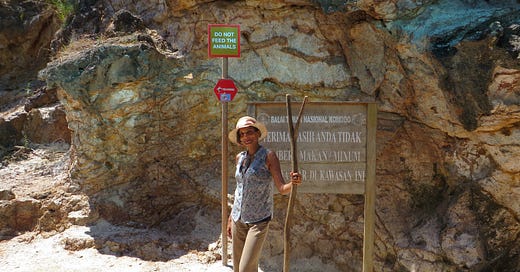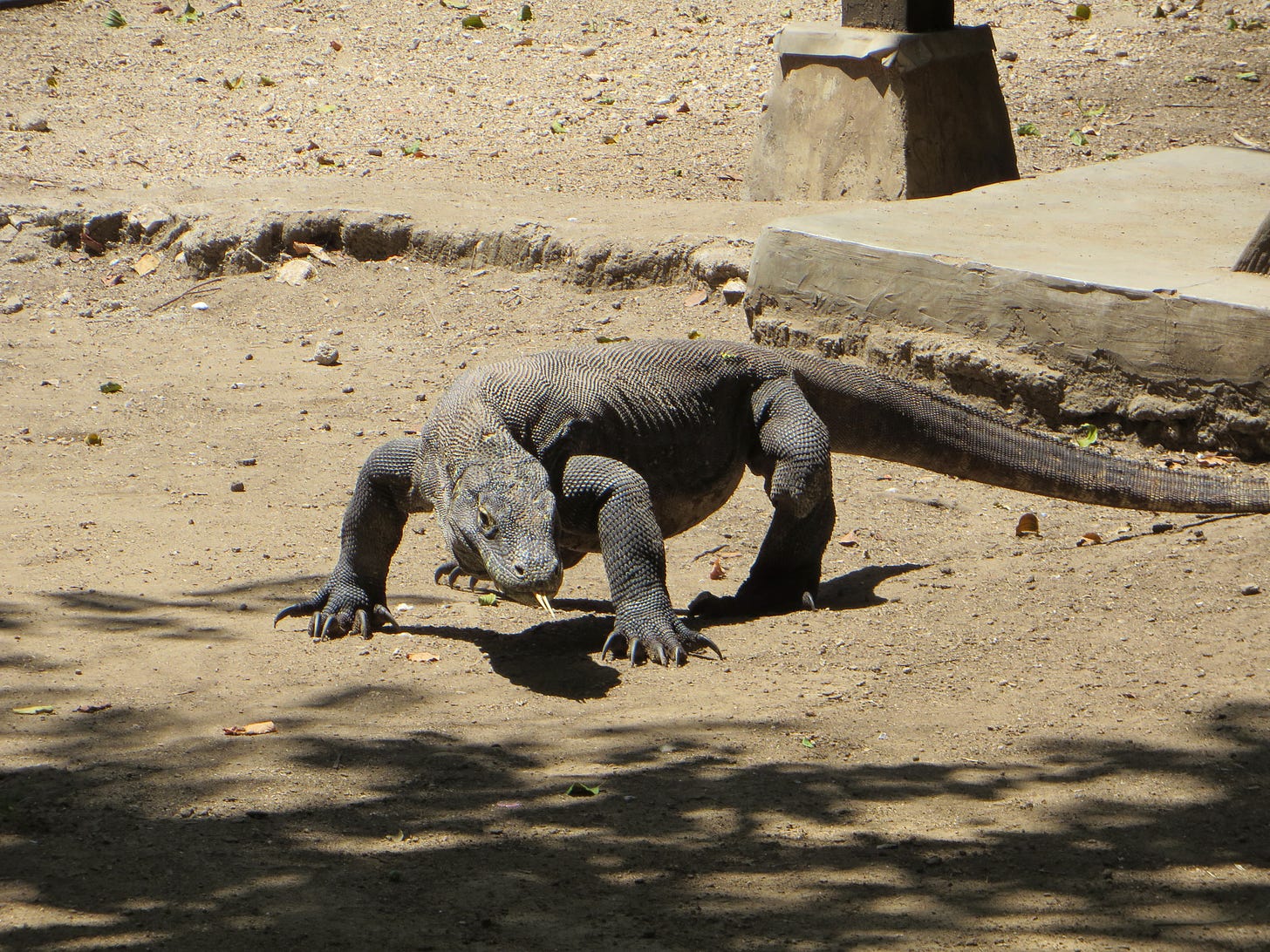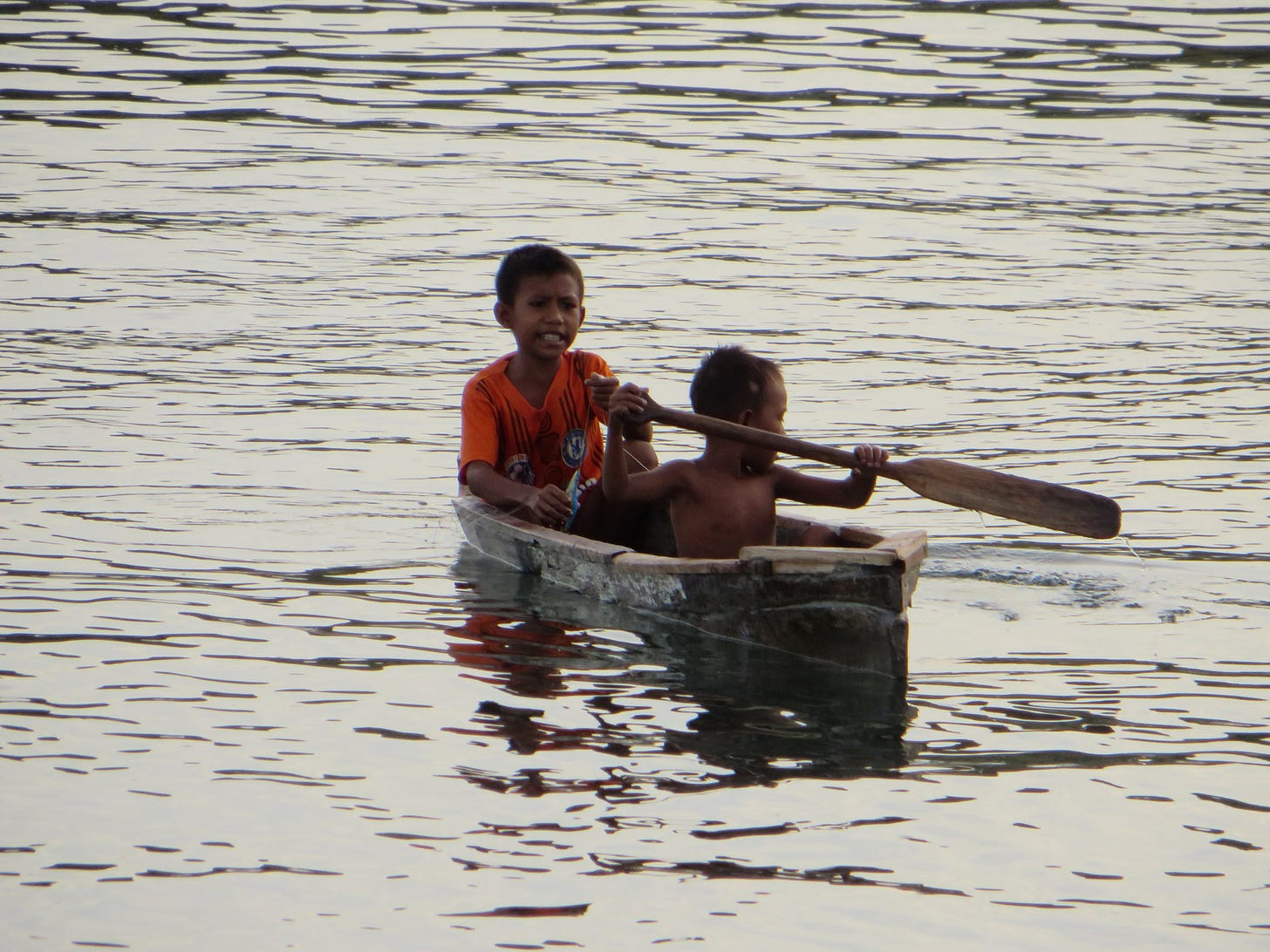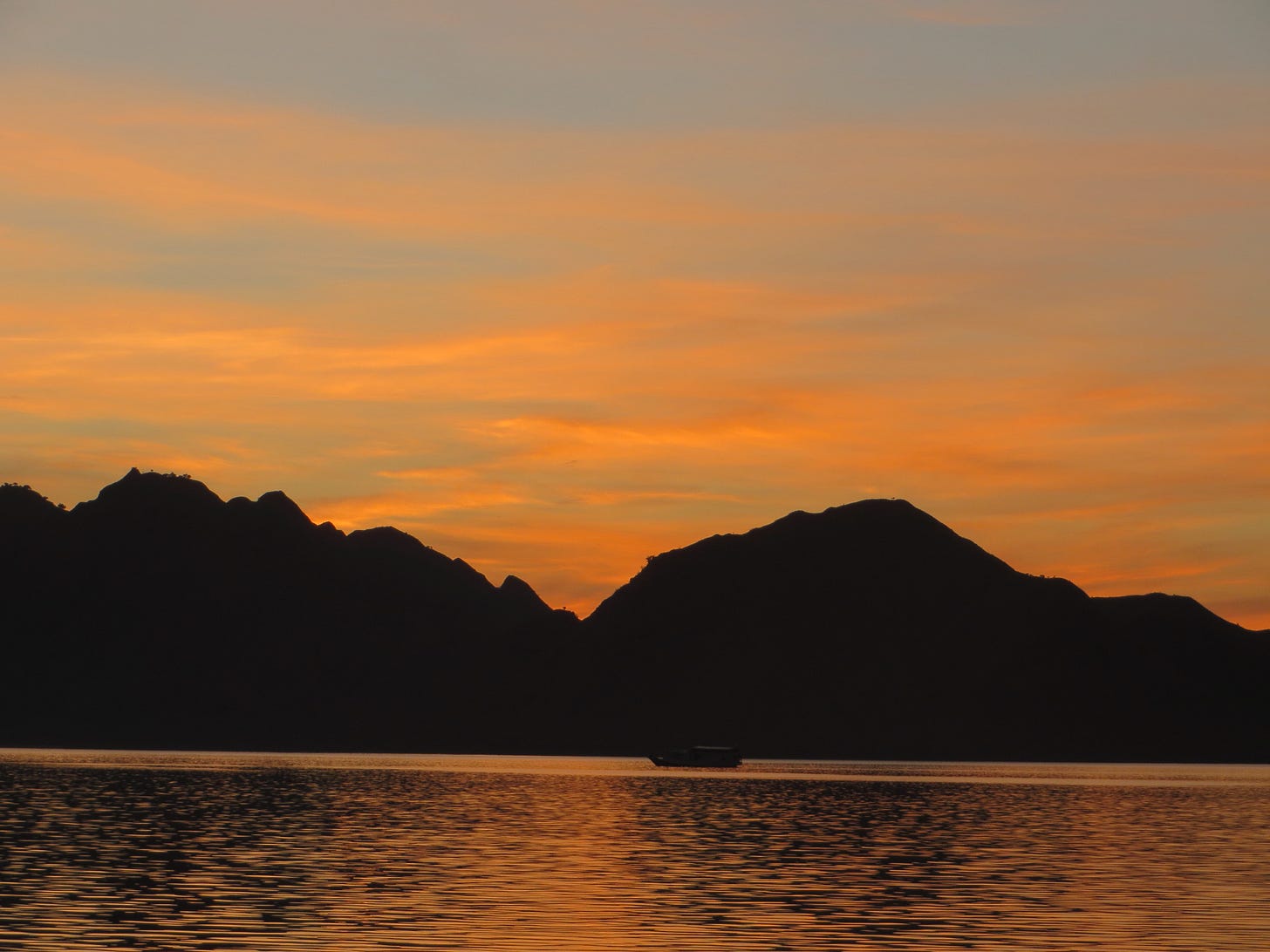Hola Global Jigsaw Friends,
In the middle of the Covid pandemic I came across an article about how the world’s largest living lizard, the Komodo, had moved one step closer to being wiped out in the wild. Previously considered a “vulnerable” species, Komodos were reclassified in 2021 by the International Union for Conservation of Nature, as “endangered.” Their habitat is expected to shrink by at least 30 percent in the next 45 years, the result of a complex of factors including rising temperatures and sea levels, urbanization and agricultural clearing. About 25 years ago, somewhere from 5,000-8,000 Komodo dragons roamed the Earth. Today, the I.U.C.N. estimates that there are just 1,380 adult Komodo dragons and another 2,000 juveniles left in the wild.
A few years ago I had the opportunity of going along with Leila, a Spanish friend, to eastern Indonesia to see the Komodos for myself. My husband, Julio refused to accompany us because of the horror stories he’d heard about the animals’ ferocity.
With the summer holidays in Europe fast approaching, I thought this would be a good moment to bring you a travelogue from Flores.
Let me know what you think. And so subscribe, if possible for you.
****
I leant into the sea breeze, as the island of Rinca loomed closer. We’d been sailing for two hours under the empty horizon that cupped this part of the South Pacific Ocean, the Flores Sea. Encrusted in dry savanna, Rinca rose out of the waters abruptly, like a gnarled and ancient creature, watching us approaching intruders with unblinking reptilian eyes. That the landscape felt anachronistic was apposite, for so were its inhabitants: dragons.
Komodo dragons are in fact a kind of overgrown monitor lizard that evolved from other reptiles of the Varanus genus some 4 million years ago. They can reach lengths of 10 feet and weigh up to 90 kilograms. For short bursts, they can run at speeds of 24 kilometers an hour, and are champion swimmers. Female dragons are capable of virgin births (in 2005 and 2006, two females at London and Chester zoos laid viable eggs despite having had no contact with male Komodos).
Considered to be the most intelligent reptiles on the planet, they are carnivorous and cannibalistic - Komodo babies spend their early years on top of trees to avoid being eaten by adults. They have snaking, forked tongues that they use to smell prey, and their mouths are full of lethal bacteria that reside in the crevices of their knife-sharp, inch-long teeth. Komodos eat 80 percent of their body weight at one sitting. And while their regular diet consists of pigs, deer, snakes and water buffalo, they occasionally snack on tourists too.
Understandably, I was a tad nervous as I stepped out of the boat and onto Rinca’s landing dock.
Me on the landing dock of Rinca holding the forked sticks that were our protection. Pic credit: Leila Fernandez
It was only 10 in the morning but already the heat was brutal. A short walk away at the island’s reception area I met with the ranger who was to be my guide and protector during this expedition. He looked 15 years old and was armed with a forked stick that appeared barely adequate to fend off a house lizard. “Stay behind me” the youngster, who came from the local village, instructed solemnly.
We set off on the shortest of three treks on offer: an hour-long saunter through largely forested terrain. All lodgings on the island were constructed on stilts to keep the heavy dragons from clambering in. The height didn’t serve as a deterrent for babies though. The little ones could shimmy up tree trunks faster than a dehydrated tourist could scream “DRAGON!” as I was just about to discover firsthand.
As we walked past the hut that served as the camp’s kitchen, loud clacking sounds emanated from its dim interior and suddenly a small Komodo flew off the balcony, chased by a stick-banging ranger. The youngster landed a foot away from where we stood and was set on a collision course with me as it hurried to get away.
I screeched like the coward it was sensible to be, and scampered for shelter behind a tree, only to notice that two adult Komodos had been sitting under the kitchen hut the entire time. By now the baby had made itself scare. The grownups however, did not look pleased at having had their siesta disturbed.
One of the scaly leviathans fixed me with a malevolent eye. But my guide was nonchalant and offered to take a picture of me with the lizards in the backdrop. The idea of turning my back on these creatures seemed about as tempting as being given a root canal by a blindfolded dentist. I passed.
A Komodo turns towards me. Pic credit: Pallavi Aiyar
In the end, it was just as well that we’d spotted these kitchen Komodos, for the walk through the park resulted in no further sightings. Back at the camp reception a troop of monkeys came cavorting out of the trees and fanned out across the open grassland. The two adult dragons were still recumbent under the kitchen hut and turned their menacing gaze away from the tourists and towards the simians. I took the opportunity to make a getaway and head back to the boat.
****
Komodo National Park, a UNESCO World Heritage Site, is located in the central-eastern part of the Indonesian archipelago and consists of three major volcanic islands: Rinca, Komodo, and Padar. I’d just visited Rinca. Komodo island was on the agenda for the following day.
That night we docked just off a village on the island. I preferred a bit of water between the dragons and me. In 2007, an 8-year-old boy was killed on Komodo Island when a dragon lunged at him as he relieved himself behind a bush. In 2009, a ranger on Rinca had been bitten at his desk by a dragon that had managed to clamber up into the office shack unnoticed. The ranger survived, but it took 55 stitches and six months for him to recover.
A tourist had not been attacked for decades, but every other person I met on the trip narrated the story of a Swiss (or German depending on whom you talked to) walker who had disappeared while trekking solo on Komodo Island sometime in the late 1980s. No trace of said gentleman, except for his spectacles and binoculars, was ever found the raconteurs claimed, with somewhat unseemly glee.
It is widely believed that dragon bites are deadly because of the numerous strains (upwards of 50) of bacteria present in their mouths. But recent research refutes this belief. Herpetologists now assert that a Komodo’s mouth is in fact quite clean, and that it is venom that causes the deaths, by causing a steep decline in the victim’s blood pressure and sending it into shock. Yet another theory hypothesizes that Komodo saliva contains an anti coagulant so that prey bleeds out from the bites. The important conclusion, from my point of view, was that one should avoid getting bitten at all costs.
An hour or so before bedtime I sat out on the deck watching the twinkling lights of the village, when I felt, rather than heard, something large slither out of the black depths of the water and into the boat. Some inglorious screaming later I found myself face-to-face with a scruffy 5-year-old, holding out tiny replicas of the dragons, fashioned out of what looked like motorbike tyres. The enterprising kid had paddled up silently in a rowboat and was now demanding an astronomical sum for his wares. I bought two in sheer relief.
Cheeky kids paddling up the our boat to hawk their wares. Pic credit: Pallavi Aiyar
At night football-sized stars hung low in the sky. Despite being a lover of creature comforts I managed to doze intermittently, lulled by the soft breeze. The sun rose early, at five, washing the horizon in pink and orange.
Komodo island at sunrise. Pic credit: Pallavi Aiyar
\Two hours later we were at the Komodo Island’s official landing dock, and off on yet another trek.
My ranger this time round seemed more interested in showing me cellphone selfies of him hugging assorted comely western tourists, than dragons. But, being up and about so early had its advantages. Halfway through our walk we spotted an adult, female some distance down a hill, perfectly camouflaged against a Komodo-coloured boulder.
We scrambled a few feet closer at which point the ranger announced that she was probably guarding a clutch of eggs. We beat a hasty retreat but were pleased with the morning’s sighting.
****
It was a four-hour journey back to Labuan Bajo on the island of Flores, the closest airport to the Komodo National Park. The ocean’s expanse spread out in its patchwork of blue, punctuated only by the occasional hump-backed island. At some point I spotted an eagle soaring amongst the wispy clouds. But then I fell asleep, tired out by the early start and hot sun. When I woke up we were about to arrive and I couldn’t be sure if I’d dreamt it.
I hope that’s whetted some appetites for summer travels. The Global Jigsaw wishes you all a fantastic break. We’ll be active through July-August, bringing you your weekly dose of global culture, travel and comment. So do keep reading and sharing. I depend on word-of-mouth publicity.
And, it bears repeating to ask you to become a paid subscriber, if possible for you.
Un abrazo fuerte,
Till next week,
Pallavi








Thank you Pallavi.. for sharing your experience with us.. it felt like I was on the trek, on the boat. I just love reading your articles!! Keep them coming!
Thank you Pallavi for sharing your adventures with Kommodos. Your writing made me feel part of your shade, while we both lingered with these frightful creatures...Another warm , beautiful article, please keep them going!